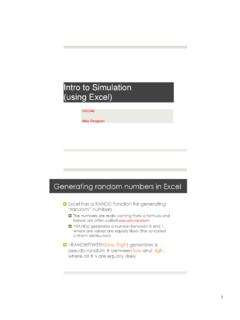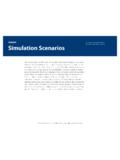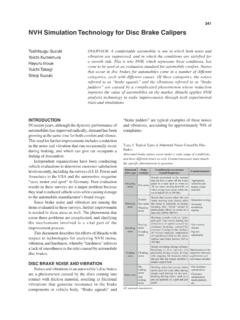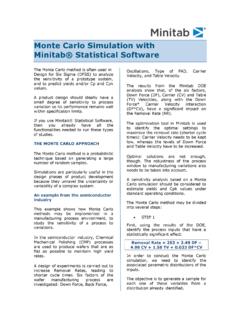Transcription of Simulation - Hadley Wickham
1 Simulation Hadley Wickham Aims Learn how to simulate data to: Test your statistical intuition Perform power tests Experiment with a new technique on known data Learn how to use functions to reduce duplication Outline Basics of Simulation Don't repeat yourself Exploring some theorem you should have seen before Exploring the behaviour of a t-test Basics of Simulation Want to: generate random numbers from known distribution want to repeat the Simulation multiple times Generating random numbers runif (uniform), rpois (poisson), rnorm (normal), rbinom (binomial), rgamma (gamma), rbeta (beta). First argument for all is n, number of samples to generate Then parameters of the distribution (always check that the distribution is parameterised the way you expect). Your turn Generate 100 numbers ~ N(0, 1). Generate 50 numbers ~ N(10, 5). Generate 1000 numbers ~ Poisson(50). Generate 10 numbers ~ Beta( , ). Generate 30 numbers ~ Uniform(0, 10).
2 Repetition Use the replicate function replicate(n, expression). replicate(10, mean(rnorm(100))). qplot(replicate(100, mean(rnorm(10))), type="histogram"). Your turn Plot histogram of: 100 x mean of 10 N(0,1). 1000 x mean of 10 Unif(0, 10). 1000 x mean of 100 Unif(0, 10). 100 x mean of 1000 Unif(0, 10). What do last three examples show? Experiment with the number of samples What your code might have looked like qplot(replicate(100, mean(norm(10))), type="histogram"). qplot(replicate(10, mean(norm(10))), type="histogram"). qplot(replicate(1000, mean(norm(10))), type="histogram"). qplot(replicate(10000, mean(norm(10))), type="histogram"). qplot(replicate(100, mean(norm(100))), type="histogram"). qplot(replicate(100, mean(norm(1000))), type="histogram"). qplot(replicate(1000, mean(norm(1))), type="histogram"). qplot(replicate(10000 mean(norm(1000))), type="histogram"). Do not repeat yourself Dry rule Why? Increases the difficulty of change May decrease clarity Leads to opportunities for inconsistency 't_repeat_yourself Functions Let us avoid repetition functionname <- function(argument1.)
3 {. # do stuff here }. Building up a function Start simple Do it outside of the function Test as you go Give it a good name Your turn Create a function that draws a histogram of n draws of mean(rnorm(100)). Modify your function to draw a histogram of n draws of mean(rnorm(m)). Modify your function to allow the user to choose which distribution function, d, to use Next task We know (hopefully) that a t test works best on normally distributed data How can we test that? Your turn Figure out how to do a in R. Figure out how to extract the p-value from that object (use str and your subsetting skills). Write a function to generate two vectors of n random normals, compare them with a and return the p-value Your turn Repeat several thousand times and draw a histogram for various values of n Try varying the parameters of the two normals. What happens when you vary the mean? What happens when you vary the standard deviation?
4 What happens if you use non-normal data? Eg. uniform, or poisson data Another exploration How does our sample estimate compare to the true unknown eg., when calculating the mean of a sample of random normals, how many do we need to draw to be reasonably certain we got the right value? What do we want to see? A plot of the different estimates, vs. number of sample points? So we need a with columns n, and sample mean (and sample sd. as well). How can we do this? Can't just use replicate New function sapply Takes first argument, and calls second argument one at a time sapply(1:10, sum) vs sum(1:10). sapply(1:10, function(n) mean(rnorm(n)). mean <- sd <- Create the data n <- rep(seq(1, 1000, by=10), each=10). mean <- sapply(n, function(x) mean(rnorm (x))). qplot(n, mean). Your turn Look at that plot for varying standard deviations What about other distributions? eg. poisson What about when you estimate the standard deviation?)
5 Try adding smoothed lines to the data (see qplot chapter mentioned last week).








